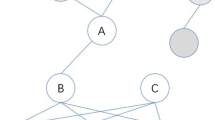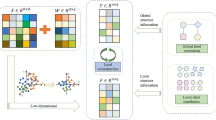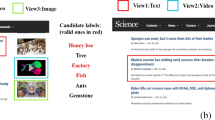Abstract
In multi-view multi-label learning (MVML), each instance is described by several heterogeneous feature representations and associated with multiple valid labels simultaneously. The key to learn from MVML data lies in how to seek a more discriminative latent subspace to exploit the consensus information across different views. In this paper, we propose a Label-Dependent Multi-view Multi-label method named M2LD, which incorporates the label information into the feature subspace to learn a more discriminative feature subspace for model induction. Specifically, we first construct a multi-view shared latent subspace across diverse views by matrix decomposition, and then the consistency relationship between labels and features is embedded to make the learned subspace label-dependent. In this way, we can preserve the local geometric structure while exploiting the consensus information of multi-view data, which leads the learned feature subspace be more discriminative. Finally, we induce the multi-view multi-label classifier by directly mapping the discriminative feature subspace to the label space. Extensive experiments on six real-world datasets indicate that our proposed M2LD can achieve superior or comparable performance against state-of-the-art methods.







Similar content being viewed by others
References
Blum A, Mitchell T (1998) Combining labeled and unlabeled data with co-training. In: Proceedings of the eleventh annual conference on computational learning theory, pp 92–100
Boutell M, Luo J, Shen X, Brown C (2004) Learning multi-label scene classification. Pattern Recogn 37(9):1757–1771
Cao X, Zhang C, Fu H, Liu S, Zhang H (2015) Diversity-induced multi-view subspace clustering. In: Proceedings of the IEEE conference on computer vision and pattern recognition, pp 586–594
Chen G, Ye D, Xing Z, Chen J, Cambria E (2017) Ensemble application of convolutional and recurrent neural networks for multi-label text categorization. In: International joint conference on neural networks, pp 2377–2383
Chen M, Huang L, Wang C, Huang D (2020) Multi-view clustering in latent embedding space. In: Proceedings of the AAAI conference on artificial intelligence, vol 34, pp 3513– 3520
Duygulu P, Barnard K, de Freitas J, Forsyth D (2002) Object recognition as machine translation: learning a lexicon for a fixed image vocabulary. In: European conference on computer vision, pp 97–112
Elhamifar E, Vidal R (2013) Sparse subspace clustering: algorithm, theory, and applications. IEEE Trans Pattern Anal Mach Intell 35(11):2765–2781
Everingham M, Eslami S, Van Gool L, Williams C, Winn J, Zisserman A (2015) The Pascal visual object classes challenge: a retrospective. Int J Comput Vis 111(1):98–136
Gao H, Nie F, Li X, Huang H (2015) Multi-view subspace clustering. In: Proceedings of the IEEE international conference on computer vision, pp 4238–4246
Gibaja E L, Ventura S (2015) A tutorial on multi-label learning. ACM Comput Surv 47 (3):1–38
Grubinger M, Clough P, Müller H, Deselaers T (2006) The iapr tc-12 benchmark: a new evaluation resource for visual information systems. In: International workshop ontoimage, vol 2, pp 13–23
Huiskes M, Lew M (2008) The mir flickr retrieval evaluation. In: Proceedings of The 1st ACM international conference on multimedia information retrieval, pp 39–43
Li X, Chen S (2021) A concise yet effective model for non-aligned incomplete multi-view and missing multi-label learning. IEEE Trans Pattern Anal Mach Intell 1–20
Li X, Guo Y (2013) Active learning with multi-label svm classification. In: International joint conference on artificial intelligence, pp 1479–1485
Li Z, Yang Y, Liu J, Zhou X, Lu H (2012) Unsupervised feature selection using nonnegative spectral analysis. In: Proceedings of the AAAI conference on artificial intelligence, vol 26, pp 1026–1032
Li Y, Nie F, Huang H, Huang J (2015) Large-scale multi-view spectral clustering via bipartite graph. In: AAAI Conference on artificial intelligence, pp 2750–2756
Liu M, Luo Y, Tao D, Xu C, Wen Y (2015) Low-rank multi-view learning in matrix completion for multi-label image classification. In: AAAI Conference on artificial intelligence, pp 2778–2784
Liu W, He J, Chang S (2010) Large graph construction for scalable semi-supervised learning. In: International conference on machine learning
Luaces O, Díez J, Barranquero J, del Coz J, Bahamonde A (2012) Binary relevance efficacy for multilabel classification. Progr Artif Intell 1(4):303–313
Moyano J, Gibaja E, Cios K, Ventura S (2018) Review of ensembles of multi-label classifiers: models, experimental study and prospects. Inf Fusion 44:33–45
Nie F, Zhu W, Li X (2017) Unsupervised large graph embedding. In: AAAI Conference on artificial intelligence
Rakotomamonjy A, Bach F, Canu S, Grandvalet Y (2008) Simplemkl. J Mach Learn Res 9:2491–2521
Read J, Pfahringer B, Holmes G, Frank E (2011) Classifier chains for multi-label classification. Mach Learn 85(3):333–359
Schietgat L, Vens C, Struyf J, Blockeel H, Kocev D, Džeroski S (2010) Predicting gene function using hierarchical multi-label decision tree ensembles. BMC Bioinform 11(1):1–14
Smith R (1968) Matrix equation xa+bx=c. SIAM J Appl Math 16(1):198–201
Szymański P, Kajdanowicz T, Kersting K (2016) How is a data-driven approach better than random choice in label space division for multi-label classification? Entropy 18(8):282
Tan Q, Yu G, Domeniconi C, Wang J, Zhang Z (2018) Incomplete multi-view weak-label learning. In: International joint conference on artificial intelligence, pp 2703–2709
Tsoumakas G, Katakis I (2007) Multi-label classification: an overview. Int J Data Warehous Min 3(3):1–13
Tsoumakas G, Katakis I, Vlahavas I (2010) Random k-labelsets for multilabel classification. IEEE Trans Knowl Data Eng 23(7):1079–1089
Von Ahn L, Dabbish L (2004) Labeling images with a computer game. In: Proceedings of the SIGCHI conference on human factors in computing systems, pp 319–326
Wang M, Fu W, Hao S, Tao D, Wu X (2016) Scalable semi-supervised learning by efficient anchor graph regularization. IEEE Trans Knowl Data Eng 28(7):1864–1877
Wang M, Fu W, Hao S, Liu H, Wu X (2017) Learning on big graph: label inference and regularization with anchor hierarchy. IEEE Trans Knowl Data Eng 29(5):1101–1114
Wang H, Yang Y, Liu B (2019a) Gmc: graph-based multi-view clustering. IEEE Trans Knowl Data Eng 32(6):1116–1129
Wang H, Yang Y, Liu B, Fujita H (2019b) A study of graph-based system for multi-view clustering. Knowl-Based Syst 163:1009–1019
Wu X, Chen Q, Hu Y, Wang D, Chang X, Wang X, Zhang M (2019) Multi-view multi-label learning with view-specific information extraction. In: International joint conference on artificial intelligence, pp 3884–3890
Wu J, Wu X, Chen Q, Hu Y, Zhang M (2020) Feature-induced manifold disambiguation for multi-view partial multi-label learning. In: Proceedings of the 26th ACM SIGKDD international conference on knowledge discovery & data mining, pp 557–565
Xiao Q, Dai J, Luo J, Fujita H (2019) Multi-view manifold regularized learning-based method for prioritizing candidate disease mirnas. Knowl-Based Syst 175:118–129
Zhang M, Zhou Z (2007) Ml-knn: a lazy learning approach to multi-label learning. Pattern Recogn 40(7):2038–2048
Zhang C, Fu H, Hu Q, Cao X, Xie Y, Tao D, Xu D (2018a) Generalized latent multi-view subspace clustering. IEEE Trans Pattern Anal Mach Intell 42(1):86–99
Zhang C, Yu Z, Hu Q, Zhu P, Liu X, Wang X (2018b) Latent semantic aware multi-view multi-label classification. In: AAAI Conference on artificial intelligence, pp 4414–4421
Zhang C, Fu H, Wang J, Li W, Cao X, Hu Q (2020a) Tensorized multi-view subspace representation learning. Int J Comput Vis 128(8):2344–2361
Zhang Y, Wu J, Cai Z, Philip S (2020b) Multi-view multi-label learning with sparse feature selection for image annotation. IEEE Trans Multimed 22(11):2844–2857
Zhang M, Fang J, Wang Y (2021) Bilabel-specific features for multi-label classification. ACM Trans Knowl Discov Data (TKDD) 16(1):1–23
Zhao J, Xie X, Xu X, Sun S (2017) Multi-view learning overview: recent progress and new challenges. Inf Fusion 38:43–54
Zhu X, Li X, Zhang S (2015) Block-row sparse multiview multilabel learning for image classification. IEEE Trans Cybern 46(2):450–461
Zhu X, Zhang S, He W, Hu R, Lei C, Zhu P (2018) One-step multi-view spectral clustering. IEEE Trans Knowl Data Eng 31(10):2022–2034
Acknowledgements
This project was supported in part by the National Natural Science Foundation of China(Nos.61872032, 61871028), in part by the Beijing Natural Science Foundation (No.4202058),in part by the National Key Research and Development Project(No.2018AAA0100300).in part by the Joint Key of Beijing Natural Science Foundation and Municipal Education Commission(No.KZ201951160050) and in part by the Beijing Advanced Talents Great Wall Scholar Training Program(No.CITTCD20190313)
Author information
Authors and Affiliations
Corresponding authors
Additional information
Publisher’s note
Springer Nature remains neutral with regard to jurisdictional claims in published maps and institutional affiliations.
Rights and permissions
About this article
Cite this article
Liu, W., Yuan, J., Lyu, G. et al. Label driven latent subspace learning for multi-view multi-label classification. Appl Intell 53, 3850–3863 (2023). https://doi.org/10.1007/s10489-022-03600-6
Accepted:
Published:
Issue Date:
DOI: https://doi.org/10.1007/s10489-022-03600-6




